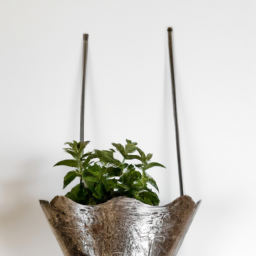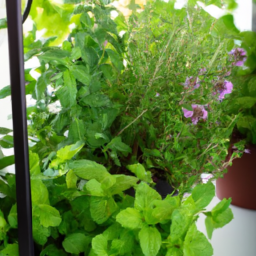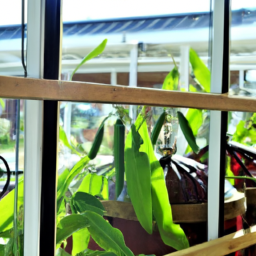
Benefits of Container Gardening: Enhancing Indoor Spaces with Plants
Introduction
Container gardening is a versatile and rewarding way to bring the beauty of nature indoors. By carefully selecting and arranging plants in containers, you can create stunning displays that not only enhance your indoor spaces but also offer numerous benefits for your well-being. In this guide, we will delve into the art of container gardening, exploring the advantages it brings and providing you with a step-by-step approach to creating breathtaking indoor plant displays.
The Therapeutic Power of Indoor Plants
Indoor plants have long been recognized for their therapeutic qualities. They not only add visual appeal to your living spaces but also contribute to your overall well-being. Research has shown that being surrounded by greenery can reduce stress levels, boost mood, and improve concentration. Container gardening allows you to bring these benefits right into your home or office, creating a calm and inviting atmosphere.
Furthermore, indoor plants have the remarkable ability to purify the air by removing toxins and releasing oxygen. They act as natural air filters, improving the quality of the air you breathe and reducing the presence of harmful substances. This can have a significant impact on your respiratory health, particularly in urban environments where pollution levels are higher.
Additionally, indoor plants can increase humidity levels in dry indoor spaces, which is especially beneficial during winter months when heating systems tend to dry out the air. By releasing moisture through a process called transpiration, plants help to create a more comfortable and healthier environment.
Choosing the Right Containers
The first step in container gardening is selecting the right containers for your indoor plants. When choosing containers, consider both the aesthetic appeal and the practical aspects. Opt for containers that complement your interior design style while also providing adequate space for the plants to grow.
Ensure that the containers have drainage holes to prevent water from pooling at the bottom, which can lead to root rot. If the containers you love do not have drainage holes, you can create a drainage layer at the bottom using pebbles or broken pottery pieces. This will allow excess water to flow out, keeping the roots healthy.
Additionally, consider the material of the containers. Ceramic and terracotta pots are popular choices due to their natural look and ability to retain moisture. However, they can be heavy and prone to breakage. Alternatively, lightweight containers made from plastic or fiberglass are durable and easy to move around.
Choosing the Right Plants
When it comes to selecting plants for your indoor container garden, consider factors such as light requirements, space availability, and personal preferences. Some plants thrive in bright, direct sunlight, while others prefer indirect or low light conditions.
Take into account the size of the mature plant and ensure that it will fit comfortably in the chosen container. Overcrowding plants can hinder their growth and lead to poor health. Consider the growth habits of the plants, such as whether they are climbers, trailing, or bushy, and plan your arrangement accordingly.
Furthermore, choose plants that are well-suited to indoor conditions and require minimal maintenance. Some popular choices for indoor container gardening include spider plants, pothos, snake plants, peace lilies, and succulents. These plants are known for their adaptability and ability to thrive in various environments.
Arranging Your Indoor Plant Display
Creating a visually appealing arrangement is a key aspect of container gardening. Consider the height, color, and texture of the plants to achieve a balanced and harmonious display.
Place taller plants at the back or in the center of your arrangement, and shorter plants towards the front or edges. This will create depth and prevent any single plant from dominating the display. Experiment with different combinations to find the arrangement that best suits your space.
Incorporate plants with different leaf shapes, sizes, and colors to add visual interest. Mix foliage plants with flowering plants to create a dynamic and vibrant display. Remember to consider the overall style and theme of your interior design when selecting plants and containers, ensuring they complement each other.
Caring for Your Indoor Plants
Proper care is essential for the health and longevity of your indoor plants. While each plant has specific care requirements, some general guidelines apply to most indoor plants.
Water your plants regularly, but avoid overwatering, as this can lead to root rot. Check the moisture level of the soil by inserting your finger about an inch deep. If it feels dry, it’s time to water. Be mindful of seasonal variations in watering needs, as plants may require less water during winter months when growth slows down.
Provide adequate light for your plants based on their specific requirements. Some plants thrive in bright, indirect light, while others can tolerate low light conditions. Observe your plants and adjust their placement accordingly to ensure they receive the right amount of light.
Fertilize your plants periodically to provide them with essential nutrients. Use a balanced, water-soluble fertilizer and follow the instructions on the packaging. Avoid over-fertilizing, as this can lead to nutrient burn and damage the plants.
Conclusion
Container gardening offers a multitude of benefits, from enhancing the aesthetic appeal of your indoor spaces to improving your well-being. By carefully selecting containers, choosing the right plants, arranging them thoughtfully, and providing proper care, you can create stunning indoor plant displays that bring nature’s beauty into your everyday life. Embrace the art of container gardening and enjoy the therapeutic and visual rewards it offers.
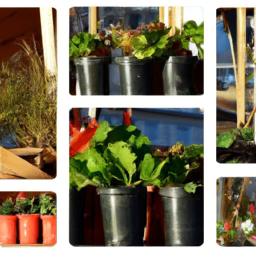
The Art of Container Gardening: Creating Stunning Indoor Plant Displays
2. Choosing the Right Containers for Indoor Plant Displays
When it comes to container gardening, selecting the right containers is essential for the success of your indoor plant displays. Not only do containers provide a home for your plants, but they also contribute to the overall aesthetic appeal of your space. In this section, we will explore the various factors to consider when choosing containers for your indoor plants.
Material
The first aspect to consider is the material of the container. Different materials offer different benefits and drawbacks, so it’s important to choose one that suits your needs and preferences. Here are some popular options:
Terra Cotta: Terra cotta pots are classic and timeless. They are porous, allowing for good airflow and drainage, which is crucial for plant health. However, they can be heavy and prone to cracking in extreme temperatures.
Plastic: Plastic containers are lightweight, inexpensive, and come in a variety of shapes and sizes. They retain moisture well and are less likely to break. However, they may not offer the same visual appeal as other materials.
Ceramic: Ceramic pots are known for their beauty and versatility. They come in a wide range of colors and designs, making them a popular choice for indoor plant displays. However, they can be fragile and may require extra care when handling and cleaning.
Size
The size of the container is another crucial factor to consider. It should be proportionate to the size of the plant you intend to grow. A container that is too small can restrict root growth and lead to stunted plants, while a container that is too large can hold excess moisture and cause root rot. As a general rule of thumb, choose a container that is approximately one-third larger than the current root ball of your plant.
Additionally, consider the height and width of the container. Taller containers are ideal for plants with long, trailing vines, while wider containers are suitable for plants with a bushier growth habit. The size of the container should also complement the overall space where you plan to display your indoor plants.
Drainage
Proper drainage is crucial for the health of your indoor plants. Without adequate drainage, excess water can accumulate in the container, leading to root rot and other moisture-related issues. When choosing containers, ensure that they have drainage holes at the bottom to allow water to escape. If you fall in love with a container that doesn’t have drainage holes, you can create them yourself using a drill or by placing a layer of gravel at the bottom to prevent waterlogging.
Remember, different plants have different moisture requirements, so it’s essential to choose containers with appropriate drainage based on the specific needs of your plants.
In conclusion, choosing the right containers for your indoor plant displays is a crucial step in successful container gardening. Consider the material, size, and drainage of the containers to ensure the health and aesthetic appeal of your plants. By selecting containers that meet the needs of your plants and complement your space, you can create stunning indoor plant displays that will be the envy of all who see them.
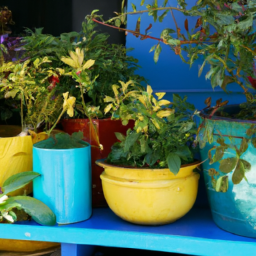
Essential Tips for Creating Stunning Indoor Plant Arrangements
Introduction
Container gardening is a wonderful way to bring the beauty of nature indoors. With the right combination of plants, containers, and design elements, you can create stunning indoor plant displays that not only enhance your living space but also provide a sense of tranquility and well-being. In this guide, we will explore the art of container gardening and provide you with essential tips to help you create your own breathtaking indoor plant arrangements.
Choosing the Right Containers
When it comes to container gardening, selecting the right containers is crucial. The containers you choose should not only complement your interior decor but also provide adequate space for the plants to grow. Here are some essential tips to consider:
1. Size: Ensure that the containers are large enough to accommodate the root systems of your chosen plants. A general rule of thumb is to select containers that are at least 2-3 times the size of the plant’s root ball.
2. Drainage: Good drainage is essential for the health of your plants. Look for containers with drainage holes at the bottom to allow excess water to escape. Alternatively, you can use a layer of gravel or pebbles at the bottom of the container to improve drainage.
3. Material: Containers are available in various materials such as ceramic, terracotta, plastic, and metal. Each material has its own advantages and disadvantages. Ceramic and terracotta containers are aesthetically pleasing but can be heavy and prone to cracking. Plastic containers are lightweight and durable but may not provide as much insulation for the roots. Consider the specific needs of your plants and your personal preferences when choosing the material.
Selecting the Right Plants
The plants you select for your indoor arrangements play a vital role in creating stunning displays. Here are some tips to help you choose the right plants:
1. Light Requirements: Assess the lighting conditions in your home and select plants that thrive in those conditions. Some plants require bright, direct sunlight, while others prefer indirect or low light. Matching the light requirements of your plants to the available light in your home will ensure their healthy growth.
2. Growth Habit: Consider the growth habit of the plants when selecting them for your container arrangements. Choose a combination of plants with varying heights, textures, and growth patterns to create visual interest and balance.
3. Maintenance: Evaluate your ability to provide the necessary care and maintenance for the plants you choose. Some plants require more frequent watering, pruning, or fertilizing than others. Select plants that align with your lifestyle and the amount of time you can dedicate to their care.
Designing Your Indoor Plant Display
Now that you have chosen the right containers and plants, it’s time to design your indoor plant display. Here are some design tips to help you create stunning arrangements:
1. Thriller, Filler, and Spiller: Follow the “thriller, filler, and spiller” technique to create visually appealing arrangements. Choose a tall, eye-catching plant as the thriller, fill in the middle with medium-sized plants as the filler, and let trailing plants spill over the edges as the spiller. This arrangement adds height, fullness, and cascading elements to your display.
2. Color and Texture: Incorporate plants with different colors and textures to add visual interest. Combine plants with vibrant flowers, variegated leaves, and unique foliage shapes to create a visually stunning display.
3. Proportions and Balance: Consider the size and shape of your containers when arranging your plants. Place taller plants towards the back or center and shorter plants towards the front or edges to create a sense of balance. Avoid overcrowding the containers and allow enough space for each plant to grow and thrive.
Maintaining Your Indoor Plant Arrangements
Once you have created your stunning indoor plant arrangements, it’s important to maintain them properly to ensure their longevity and beauty. Here are some maintenance tips:
1. Watering: Follow a regular watering schedule, but be mindful not to overwater or underwater your plants. Most indoor plants prefer slightly moist soil, so check the moisture level before watering. Avoid letting the plants sit in standing water, as it can lead to root rot.
2. Fertilizing: Provide your plants with the necessary nutrients by fertilizing them regularly. Use a balanced, water-soluble fertilizer according to the instructions on the package. Avoid overfertilization, as it can damage the plants.
3. Pruning and Grooming: Trim and prune your plants as needed to maintain their shape and remove any dead or yellowing leaves. Regular grooming will keep your arrangements looking neat and well-maintained.
Conclusion
Container gardening is a delightful way to bring the beauty and serenity of nature into your home. By following these essential tips for creating stunning indoor plant arrangements, you can transform your living space into a green oasis. Remember to choose the right containers and plants, design your arrangements thoughtfully, and maintain them with care. With a little creativity and attention, you can enjoy the art of container gardening and create breathtaking displays that will captivate and inspire.
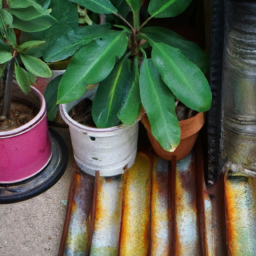
Selecting the Perfect Plants for Container Gardening Indoors
Container gardening is a wonderful way to bring the beauty of nature indoors, creating stunning displays of plants that can transform any space. When it comes to selecting the perfect plants for your indoor container garden, there are a few key factors to consider. In this guide, we will walk you through the process of choosing the ideal plants for your indoor space, ensuring that your container garden thrives and brings joy to your home.
1. Assessing Light Conditions
The first step in selecting plants for your indoor container garden is to assess the light conditions in your space. Different plants have different light requirements, and it is important to choose plants that will thrive in the available light.
If you have a sunny spot with direct sunlight for several hours a day, you can choose plants that require full sun, such as succulents, cacti, or herbs like rosemary and thyme. On the other hand, if your space has limited light, you can opt for low-light plants like pothos, snake plants, or peace lilies.
It is essential to match the light requirements of the plants with the available light in your indoor space to ensure their healthy growth and development.
2. Considering Space and Size
When selecting plants for your indoor container garden, it is crucial to consider the available space and size constraints. Some plants, like trailing vines or cascading plants, are perfect for hanging baskets or tall containers, while others may require wider pots to accommodate their root systems.
If you have limited space, you can choose compact plants like dwarf varieties of herbs, flowers, or even small fruit trees. These plants will not only fit well in smaller containers but also add a touch of beauty and fragrance to your indoor space.
On the other hand, if you have ample space, you can experiment with larger plants like palms, fiddle leaf figs, or bird of paradise, which can serve as bold focal points in your indoor garden.
3. Understanding Watering and Maintenance Needs
Another crucial factor to consider when selecting plants for your indoor container garden is their watering and maintenance needs. Some plants require frequent watering, while others prefer drier conditions. It is important to choose plants that align with your lifestyle and the time you can dedicate to their care.
If you are a busy individual or frequently travel, opting for low-maintenance plants like succulents, ZZ plants, or spider plants can be a great choice. These plants require less frequent watering and can tolerate periods of neglect.
However, if you enjoy tending to your plants and have the time to provide them with regular care, you can opt for more demanding plants like orchids, ferns, or flowering plants. These plants often require specific watering schedules, humidity levels, and fertilization to thrive.
By understanding the watering and maintenance needs of different plants, you can ensure a successful and flourishing indoor container garden.
Container gardening indoors is a rewarding and creative endeavor that allows you to bring the beauty of nature into your home. By assessing light conditions, considering space and size, and understanding watering and maintenance needs, you can select the perfect plants for your indoor container garden. So, go ahead and create stunning displays of greenery and transform your indoor space into a haven of natural beauty!
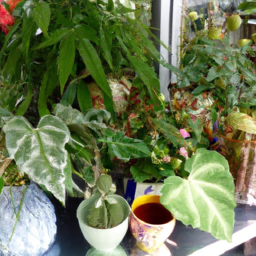
Maintaining and Caring for Indoor Plants in Container Gardens
Introduction
Container gardening is a wonderful way to bring the beauty of plants indoors and create stunning displays that enhance the aesthetics of your living space. However, to ensure that your indoor plants thrive and continue to add charm to your home, it is essential to provide them with proper care and maintenance. In this guide, we will explore the art of maintaining and caring for indoor plants in container gardens, offering step-by-step instructions and valuable tips to help you create a flourishing indoor oasis.
1. Choosing the Right Containers
The first step in maintaining and caring for indoor plants in container gardens is selecting the right containers. Consider the size, material, and drainage capabilities of the containers. Ensure that they have sufficient drainage holes to prevent waterlogging, as excess moisture can lead to root rot and other problems. Opt for containers that are slightly larger than the root ball of your plants to allow for growth and ensure proper airflow.
When it comes to material, clay pots are popular for their breathability, but they can dry out quickly. Plastic and fiberglass containers retain moisture better and are lighter in weight. Choose containers that match your interior décor style and provide adequate support for your plants.
2. Choosing the Right Soil
The soil you use in your container garden plays a crucial role in the health and growth of your indoor plants. Opt for a high-quality potting mix that is well-draining and rich in organic matter. Avoid using garden soil, as it tends to be too heavy and may contain pests or diseases.
Consider the specific needs of your plants when selecting soil. Some plants, such as succulents, prefer sandy and well-draining soil, while others thrive in loamy or peat-based mixes. Research the requirements of your plants and choose a soil mix that suits their needs.
3. Watering Techniques
Proper watering is essential for the well-being of your indoor plants. Overwatering or underwatering can lead to various issues, including root rot, wilting, and stunted growth. Here are some watering techniques to keep in mind:
– Check the moisture level of the soil regularly by sticking your finger about an inch deep into the soil. If it feels dry, it’s time to water your plants. If it feels moist, hold off on watering.
– Water your plants thoroughly until water drains out of the drainage holes. This ensures that the entire root system receives moisture.
– Avoid leaving your plants sitting in excess water, as it can lead to root rot. Empty the saucers or trays underneath the containers after watering.
– Adjust your watering frequency based on the season and the specific needs of your plants. Some plants may require more water during the summer months, while others may need less during the dormant period.
4. Providing Adequate Light
Light is one of the most crucial factors for the growth and health of indoor plants. Different plants have varying light requirements, so it’s essential to understand the needs of your specific plants. Here are some general guidelines:
– Place your plants near windows that receive bright, indirect light. Avoid exposing them to direct sunlight, as it can scorch the leaves.
– If your home lacks natural light, consider using artificial grow lights to provide the necessary light spectrum for your plants.
– Rotate your plants regularly to ensure even light distribution and prevent them from leaning towards the light source.
– Monitor your plants for signs of inadequate or excessive light. Pale leaves, leggy growth, or lack of flowering may indicate insufficient light, while scorched leaves or stunted growth can indicate excessive light.
5. Fertilizing Routine
To keep your indoor plants healthy and thriving, it’s essential to provide them with the necessary nutrients. Fertilizers can replenish the soil’s nutrient content and promote vigorous growth. Here are some tips for fertilizing your container garden:
– Choose a balanced, water-soluble fertilizer specifically formulated for indoor plants. Follow the instructions on the packaging for proper dilution and application rates.
– Apply fertilizer during the growing season, typically from spring to early fall. Reduce or stop fertilization during the dormant period.
– Avoid overfertilizing, as it can lead to salt buildup in the soil, burning the roots of your plants. Always follow the recommended dosage and frequency.
– Consider using organic fertilizers, such as compost or worm castings, for a more sustainable and environmentally friendly approach.
Conclusion
Maintaining and caring for indoor plants in container gardens requires attention to detail and a deep understanding of the specific needs of your plants. By choosing the right containers and soil, providing adequate water and light, and implementing a proper fertilizing routine, you can create stunning indoor plant displays that thrive and bring joy to your living space. Remember to observe your plants closely, as they will often communicate their needs through visual cues. With patience and dedication, you can master the art of container gardening and enjoy the beauty of indoor plants for years to come.
Frequently Asked Questions (FAQ)
1. What is container gardening?
Container gardening refers to the practice of growing plants in containers or pots instead of planting them directly in the ground. It allows you to create stunning indoor plant displays by utilizing various types of containers and plant arrangements.
2. What are the benefits of container gardening?
Container gardening offers several benefits, including flexibility in plant placement, easy maintenance, and the ability to grow plants in limited spaces. It also allows you to control the soil quality, water drainage, and sunlight exposure for each plant.
3. Which plants are suitable for container gardening?
A wide variety of plants can thrive in containers, including flowers, herbs, vegetables, and even small trees or shrubs. Choose plants that are well-suited to your indoor environment and consider their growth habits, light requirements, and container size.
4. How do I choose the right container for my plants?
When selecting a container, consider factors such as size, material, and drainage. Ensure the container has drainage holes to prevent waterlogging and choose a size that allows sufficient root space for your plants to grow. Different materials, such as clay, plastic, or wood, have different moisture retention properties.
5. What type of soil should I use for container gardening?
It’s important to use a well-draining potting mix specifically formulated for container gardening. These mixes usually contain a blend of peat moss, perlite, vermiculite, and other organic matter that provides proper aeration and moisture retention for the plants.
6. How often should I water my container plants?
The watering frequency depends on various factors, including the plant species, container size, and environmental conditions. Generally, it’s recommended to water container plants when the top inch of soil feels dry. Avoid overwatering, as it can lead to root rot.
7. How do I fertilize container plants?
Container plants often require regular fertilization as nutrients in the potting mix can deplete over time. Use a balanced slow-release fertilizer or liquid fertilizer according to the recommended dosage for your specific plants. Be cautious not to over-fertilize, as it can harm the plants.
8. Can I move my container plants outdoors?
Yes, many container plants can be moved outdoors during suitable weather conditions. However, ensure that the plants are gradually acclimated to the outdoor environment to prevent shock. Consider factors such as temperature, sunlight exposure, and wind when deciding to move your plants outside.
9. How do I prevent pests and diseases in container gardening?
Regularly inspect your plants for any signs of pests or diseases. Implement preventive measures such as using sterile potting mix, practicing good sanitation, and providing proper air circulation. If necessary, treat pest or disease issues with organic or chemical solutions specifically designed for container gardening.
10. Are there any additional resources for learning about container gardening?
Absolutely! There are numerous books, online articles, and gardening forums dedicated to container gardening. You can also consider attending workshops or seeking advice from local nurseries or experienced gardeners to enhance your knowledge and skills in creating stunning indoor plant displays.

Lisa Chen is a seasoned indoor gardening expert and the author of several bestselling books on the topic. With a background in horticulture and urban farming, Lisa is dedicated to helping urban dwellers embrace the joys of cultivating green spaces indoors. Her detailed guides and hands-on tips empower readers to transform their living spaces into thriving plant sanctuaries.

